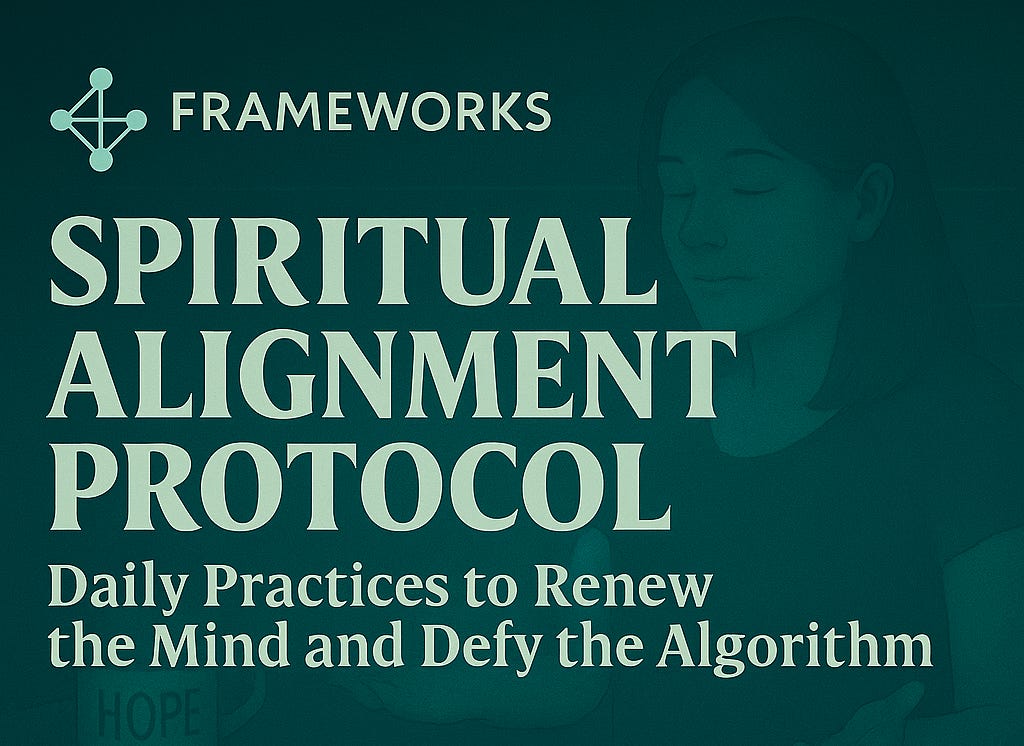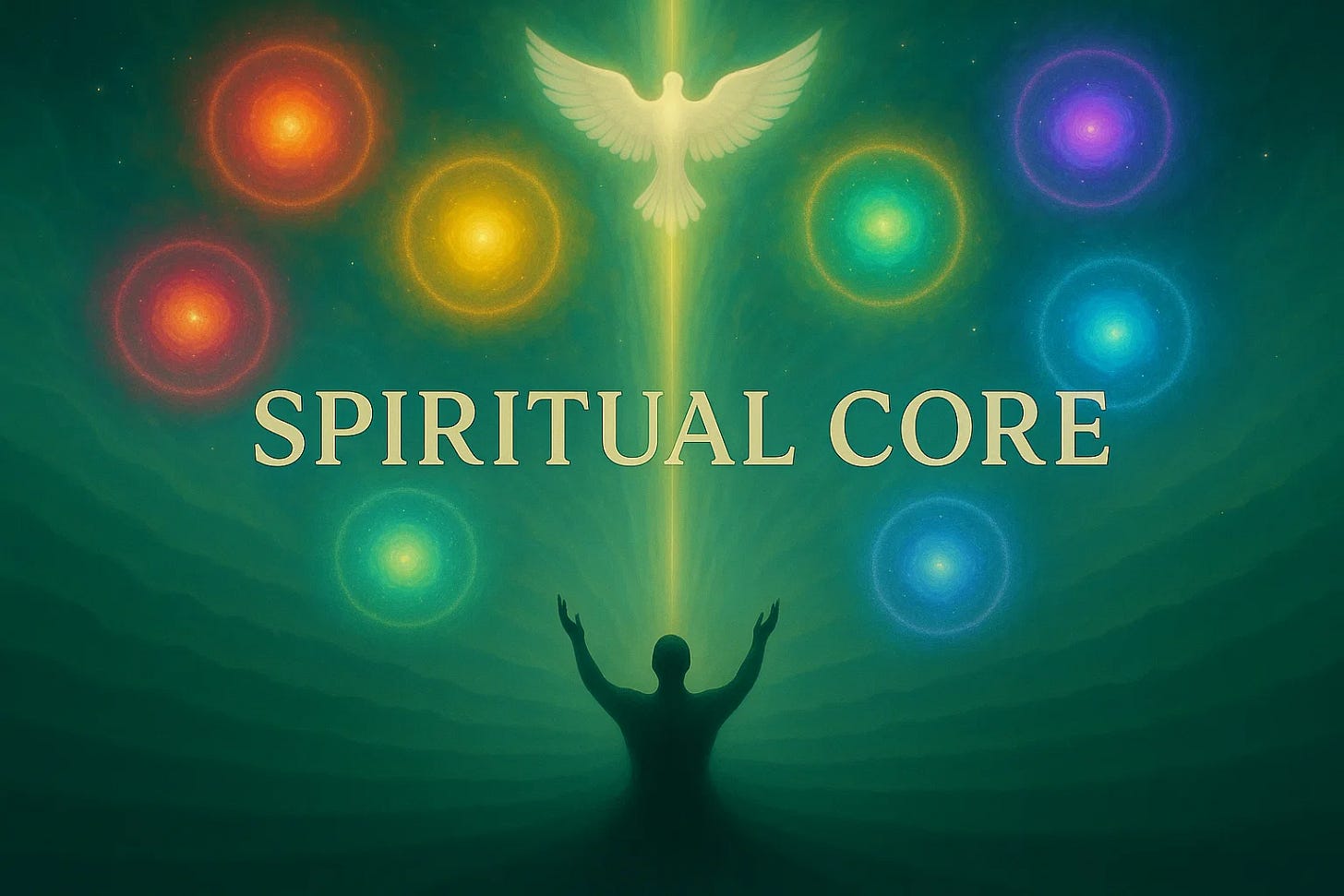Framework: Spiritual Alignment Protocol
Daily Practices to Renew the Mind and Defy the Algorithm
How You Begin Shapes Everything That Follows.
Each day begins with calibration—whether you choose it or not. Before you're fully awake, something has already begun shaping your mental framework: a notification, a headline, a task list, a stray thought disguised as urgency. You scroll through curated chaos before you’ve even thought your own thoughts.
Without realizing it, our cognitive framework begins forming the moment we open our eyes. And if we don’t set that frame with intention, the world will gladly do it for us.
This isn’t a call to unplug or retreat. It’s an invitation to notice. Not to reject modern life or shun technology, but to consider: What would it look like to begin each day from a place of clarity rather than chaos? What if our mental filters were renewed—not just refreshed—and shaped by something deeper than the day's demands?
Spiritual Alignment isn’t about rule-following or ritual for ritual’s sake—it’s a method of re-centering, of consciously renewing your mental filters in a world built on urgency and engineered distraction. It’s not about escaping reality; it’s about entering it with intention.
What if the day began with truth—not distraction? With reflection—not reaction? If the first voice you hear is timeless, not trending?
This isn’t doctrine. It’s design. A framework for thinking more clearly—starting from within.
This isn't to tell you what to think, but to help you examine how you think.
A quiet system for daily clarity—rooted in something deeper than the feed.
In the pages ahead, we’ll explore:
The spiritual foundation behind why alignment matters to the soul
The neuroscience that explains how your brain reacts to repeated input
A habit-building approach for turning alignment into a rhythm, not a rule
Five daily and weekly anchor points to help you recalibrate your thoughts, your emotions, and your attention
We Are Spiritual Beings First—By Design.
Before we can align, we need to recognize what is being aligned. And that begins with a simple truth: we are not just minds with thoughts or bodies with tasks—we are spiritual beings. That’s not metaphor. That’s design-level reality:
"Then the LORD God formed the man of dust from the ground and breathed into his nostrils the breath of life, and the man became a living creature." (Genesis 2:7)
"The spirit of man is the lamp of the Lord, searching all his innermost parts." (Proverbs 20:27)
"For what can be known about God is plain to them... For his invisible attributes... have been clearly perceived... in the things that have been made." (Romans 1:19-20)
"Do not be conformed to this world, but be transformed by the renewal of your mind..." (Romans 12:2)
Scripture does not speak to us as brains. It speaks to us as souls—thinking, feeling, breathing image-bearers. The world will always reduce us to algorithms, appetites, or avatars. But God begins with something higher: identity, relationship, purpose.
Throughout Scripture, alignment with God is not merely personal—it’s covenantal. The call to walk with God is repeated from Genesis to Revelation. Abraham walked by faith. David sought God's heart. Jesus Himself rose early to commune with the Father (Mark 1:35). Alignment isn't a modern invention; it's a sacred pattern.
The Spiritual Alignment Protocol exists to help reassert that truth—not as a sermon, but as a daily system. A rhythm. A design pattern that restores agency, filters noise, and reconnects thought with Truth.
The calibration sequence involves five moments where alignment takes root. It speaks to us as image-bearers: created, intentional, connected. It calls us to transformation not by force of will, but by renewal of the mind—a deeply spiritual act.
“Do not be conformed to this world, but be transformed by the renewal of your mind...” (Romans 12:2)
Spiritual alignment is the posture of a soul returning to source. It is a daily decision to begin—not with noise, but with knowing.
COGNITIVE GROUNDING
Theology gives us the why. Neuroscience helps us understand the how.
Spiritual alignment isn’t just theological—it’s neurological. What we practice shapes what we perceive. And over time, repeated inputs form not just habits, but neural architecture. This is the beauty of design: our brains were built to align.
Here’s how spiritual practices operate under the hood:
RAS Filtering — The Reticular Activating System (RAS) is your brain’s filter. It determines what gets through to conscious attention. Begin your day with alignment—prayer, scripture, stillness—and you prime that filter to recognize peace over panic, purpose over noise. It’s not magic. It’s mechanics.
Neuroplasticity and Renewal — Romans 12:2 commands the renewal of the mind. Neuroscience confirms it: focused, repeated thought rewires the brain. Spiritual practices like prayer, meditation, and worship strengthen the prefrontal cortex, where self-regulation and higher-order thinking live.
Cortisol & Calm — Gratitude isn’t just spiritual—it’s chemical. It lowers cortisol. Confession reduces mental load. Prayer activates the parasympathetic nervous system. When we realign with God, we also physiologically step out of fight-or-flight mode—and back into regulated clarity.
Attention Residue Management — Unfinished tasks, unresolved thoughts, and constant switching leave residue in the mind. The Alignment Protocol breaks those loops. Micro-practices—especially midday recalibrations—allow your brain to reset rather than spiral.
Decision Fatigue Defense — Every decision costs energy, drawing from a finite supply of willpower. A spiritually aligned mind offloads low-level noise and reinforces your spiritual center—your core identity. You stop asking "What should I do?" and start remembering "Who am I becoming?"
These aren’t just beliefs. They’re biological reinforcements. When spiritual design and neural design work together, clarity compounds.
Your spiritual operating system and your neural operating system are not in conflict. They’re made to cooperate.
BUILDING ALIGNMENT AS HABIT
Spiritual alignment doesn't become a lifestyle overnight. Like anything worth building, it becomes a habit through intentional repetition, consistency, and simplicity.
The key to lasting alignment is to keep the threshold low and the access points visible. You don’t need a 90-minute quiet time or a silent retreat to start. You need a pattern that fits your real life.
Here are some practical ways to build these rhythms into your day:
Start with a cue. Attach spiritual practices to something you already do: wake up? Open the Bible app before checking email. Pour coffee? Say a short prayer of gratitude. Park your car? Take 10 seconds of stillness before heading in.
Make it small. One verse. One breath. One truth. Don’t let scale sabotage your consistency. If you only have one minute, use that minute to realign.
Place truth in your path. Set your lock screen to Scripture. Leave a Bible or journal where you’ll see it first. Use sticky notes or visual reminders near your mirror, fridge, or steering wheel.
Build a micro-routine. A short, repeatable series of actions builds memory and momentum. For example: Light a candle. Read a verse. Reflect. Pray. Close in silence. The simplicity makes it sustainable.
Stack with existing habits. Brushing teeth, making coffee, walking to your car—these can become alignment triggers. You don’t need new time, just new intent.
Reflect on the reward. End each practice by asking: Did I feel more grounded? More peaceful? More present? Let your spirit learn the benefit so your brain reinforces the habit.
The goal is not perfection. The goal is return. These aren’t checklists—they’re recalibration points. Over time, they become reflexes.
The more you build them in, the more they build you up.
THE FIVE ALIGNMENTS
This framework flows across five distinct alignments—anchoring points throughout the day and week. Each moment offers a low-friction opportunity to realign the mind and spirit in the flow of life. These are not rigid rituals; they’re flexible tools. You can adapt them to your context, scale them to your capacity, and return to them without shame whenever you drift.
Each alignment is supported by a cue, a simple action, and an anchoring system hook—habits you can attach it to. You don’t need all five to start. Begin where the friction is highest, or where the quiet is missing. Let the protocol grow with you.
Here’s how the rhythm plays out—and what it might look like in the real world.
1. Morning Calibration
Spiritual Cue: Waking up
Action: Scripture or silent prayer
System Hook: Leave your Bible or journal on your nightstand; silence your phone overnight.
The morning is not a blank slate—it’s a doorway. And the first thing through that doorway sets the tone for everything else. In the Psalms, David writes, “O LORD, in the morning you hear my voice; in the morning I prepare a sacrifice for you and watch” (Psalm 5:3). This was the pattern of Christ as well, who withdrew early to desolate places to pray (Mark 1:35).
Start small: open a Bible app before opening social media. Whisper a short prayer while sitting up in bed. You don’t need a perfect ritual. You need a consistent reset.
And once the habit takes hold, you can let it expand. Let the posture of alignment continue while brushing your teeth, pouring your coffee, or standing under the shower. Keep the conversation going. Let the truth stretch across your routine.
The key is to start with alignment—not to insert it later. When it’s first, it flows. When it’s delayed, it competes.
This is where the brain’s RAS gets its marching orders. Start it on truth.
2. Midday Recalibration
Spiritual Cue: Mental fatigue, tension, or drift
Action: 2-minute reset—breathe, pray, realign
System Hook: Set a calendar reminder or use a verse as your phone lock screen
The day rarely unfolds the way we imagined. Clarity at sunrise often gives way to clutter by noon. Midday recalibration keeps the spiritual compass from spinning.
You can start this habit with a single breath prayer. Just one phrase and one exhale. But you can grow it: take a walk without headphones, step outside and let the sun hit your face, jot a sentence of gratitude in a notebook.
What matters is not the length of time—but the pause, the redirection, and the return.
Even a micro-dose of intentional stillness reboots cognition and centers the soul.
3. Situational Shielding
Spiritual Cue: High-noise or high-stakes situations
Action: One-sentence prayer or truth anchor
System Hook: Pause before you open a door, enter a meeting, or check your phone
You can’t script every challenge, but you can script your posture.
This practice might start with just one breath before walking into a room. But over time, it can grow: memorized verses for difficult conversations, pausing for 60 seconds before opening your inbox, or praying silently before responding to a tough message.
The more you use it, the more your spirit will preemptively brace—not in fear, but in peace.
These pocket-size resets reduce reactivity and reinforce agency.
4. Evening Release
Spiritual Cue: End of day, winding down
Action: Reflect, confess, and surrender
System Hook: Anchor the practice to a habit—brushing teeth, turning off lights, etc.
What is unspoken during the day gets rehearsed at night. The mind replays loops. The soul replays burdens.
You might begin by simply whispering a phrase: “Thank you for today.” Or asking, “Where did I drift?”
As this practice becomes natural, let it grow: journal a line or two, take a few minutes of quiet reflection before bed, or replay the day with God as a companion. You might sit comfortably, hold your hands open in a posture of release, or simply turn off the lights and talk to God aloud or silently—whatever helps you mark the end of the day with grace. Use this as a release mechanism.
Keep it light, but let it be real. End the day with release, not residue.
Release doesn’t mean resolution. It means transfer. Let God carry what you were never meant to keep.
5. Weekly Reset
Spiritual Cue: Weekly rhythm
Action: Sabbath observance, worship, silence, or tech disconnect
System Hook: Block time in your calendar and pre-commit to saying “no”
God created in rhythm—and gave us permission to rest in that rhythm. From the beginning, Sabbath was woven into the created order: “On the seventh day God finished his work that he had done, and he rested…” (Genesis 2:2–3). It was later codified in the Ten Commandments (Exodus 20:8–11).
But the most liberating view of Sabbath comes through the words of Jesus: “The Sabbath was made for man, not man for the Sabbath” (Mark 2:27). This is not a rule to be followed legalistically—it’s a gift to be received intentionally. Sabbath is not about performance or obligation. It’s about restoration, relationship, and realignment.
Start with what you can: a few hours without your phone. A morning walk. A worship playlist. Over time, let it expand. Block out an entire day. Invite others into the rhythm. Reclaim joy, not just rest.
Make it your own: light a candle and create a physical cue for peace. Turn off notifications and unplug from the churn of obligation. Take a walk and let your pace reset your pulse. Worship with friends or sit quietly with Scripture. Take a nap. Linger over a meal. Say yes to joy and no to hustle. The only requirement is this: be present. Whatever draws your heart back to God and your body back to rest—start there. Choose presence over production.
Sabbath is your weekly act of defiance against hustle culture. You are not your output. You are not your inbox. You are a soul.
SYSTEM CHECK
How to Know When It’s Working—and What to Do When It’s Not
You don’t need a checklist to know when alignment is happening. You’ll feel it. There’s a quiet clarity. A calm undercurrent. A sense that you’re moving through the day with intention, not just inertia.
You also know when it’s not. You react before you reflect. You chase noise. You feel untethered. Your mind spirals. Your soul forgets what it already knows.
That’s not failure. That’s a cue.
The System Check is your moment to pause and ask:
Have I been beginning with alignment—or with urgency?
Are my inputs feeding peace or feeding panic?
Is this rhythm helping me return—or just making me feel behind?
When the answer stings, don’t abandon the framework—return to it. Gently. Humbly. Today is always a fresh starting point.
Spiritual clarity isn’t built on streaks. It’s built on return.
Here are five likely failure points to watch for:
Ritual Over Renewal
It’s easy to slip into automation. When the framework becomes a checklist, we lose the point. Alignment begins in the heart. Return to presence, not performance.False Urgency Will Test You
Disruption will happen. You’ll skip a morning or forget a reset. Don’t rush to “catch up”—just re-enter. Skipping alignment to gain time is like skipping oxygen to gain speed.Shallow Inputs, Shallow Roots
You can scroll past a verse without reading it. You can mutter a prayer without meaning it. Realignment requires depth. Even small doses of truth need space to take root.Guilt Spirals Are a Trap
Missing a rhythm doesn’t mean you’ve failed. The enemy of alignment isn’t failure—it’s shame. Start again. Begin mid-stream. There’s no expiration on grace.The Cultural Gravity is Strong
The world pushes noise, speed, comparison, and fear. Alignment pushes back with stillness, clarity, and trust. One is louder. The other is stronger—if you make space for it.
This framework doesn’t require perfection. It invites participation.
Return. Recalibrate. Repeat.
FINAL TRANSMISSION
I’ll be honest—this isn’t a protocol I’ve mastered. It’s one I’m adopting. A practice I’m trying to make real. This isn’t written from the top of the mountain. It’s a map I drew while still climbing.
There are days I forget to calibrate. Days where the first voice I hear is distraction, not truth. Days where I let the algorithm shape my attention before the Word ever gets a chance. I’m not immune to the pull of urgency, performance, or the dopamine loop.
This protocol isn’t just for you. It’s for me.
And I’ve seen the difference it makes—most clearly in the life of my wife. She is the model I hope to emulate. Every morning, without fail, she begins in the Word. She sings praise songs while getting ready, letting joy leak into every corner of her routine. Her peace isn’t performative. It’s planted. I watch her, and I see the fruit of consistent alignment.
I want that.
This framework isn’t about achieving perfection. It’s about returning to what matters. Again and again. Reframing the day before the day reframes you.
This is how we renew the mind. This is how we clear signal from noise.
And tomorrow—I’ll try again.
[FIN/ACK]
Transmission Complete
Process Accordingly.
—Protocol One
If this piece helped you rewire your thinking, strengthen your faith, or navigate tough relationships, consider buying me a coffee.
Your support keeps these transformation tools sharp, practical, and freely available.
☕ Support the work: buymeacoffee.com/protocolone
Afterword:
This isn’t a chiseled-in-stone protocol. It’s a living, breathing framework—something that evolves through practice and conversation. If something here resonates, build on it. If something’s missing, help me fill it in.
The comments are open. Let me know what’s working for you. What helps. What doesn’t. We grow this together.










